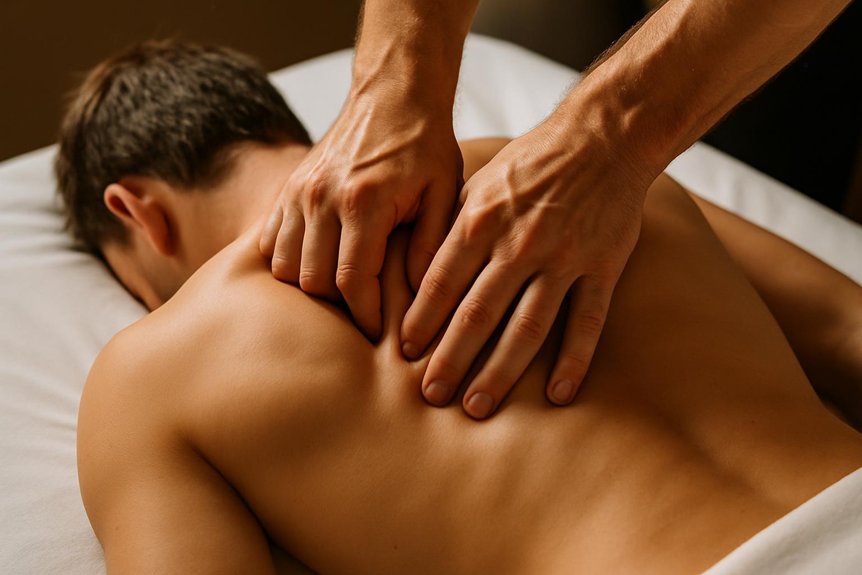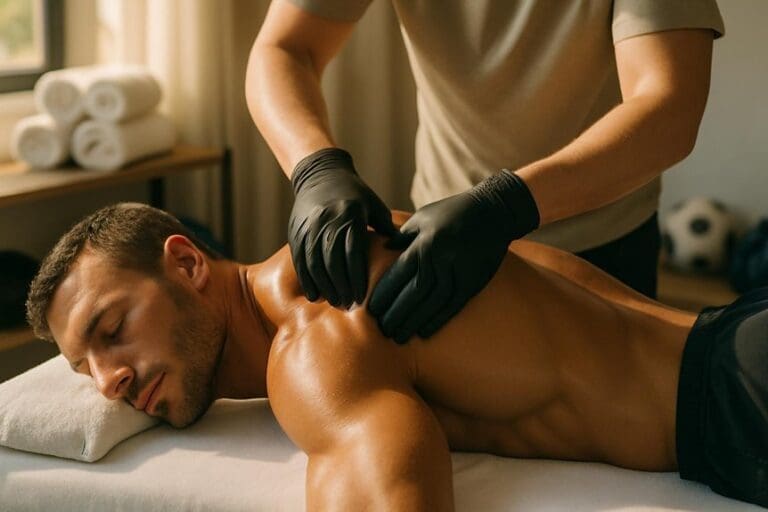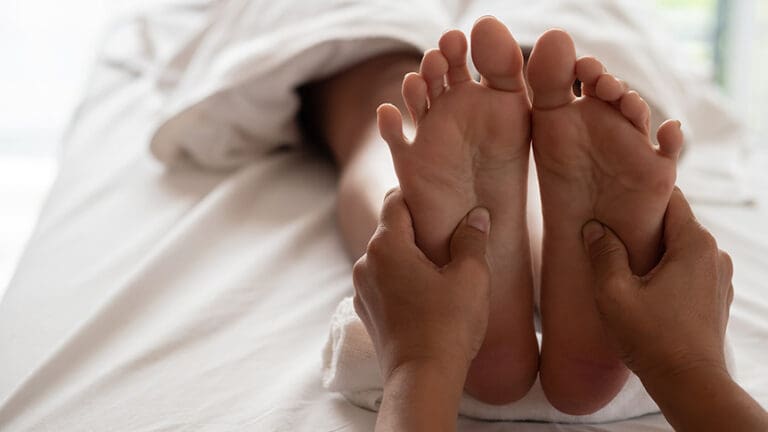This massage can help certain “pinched nerve” cases by reducing myofascial tension, improving local perfusion, and easing mechanical irritation around nerve roots or peripheral entrapment sites (e.g., paraspinals, scalenes, piriformis). Clinicians use graded pressure, trigger point release, heat, and gentle nerve glides while staying below symptom thresholds. It is inappropriate with red flags such as progressive weakness, bowel/bladder changes, trauma, or infection. Stable, mechanically provoked symptoms often respond, and appropriate technique selection and precautions matter to outcomes.
What Is a Pinched Nerve and How Does It Feel?
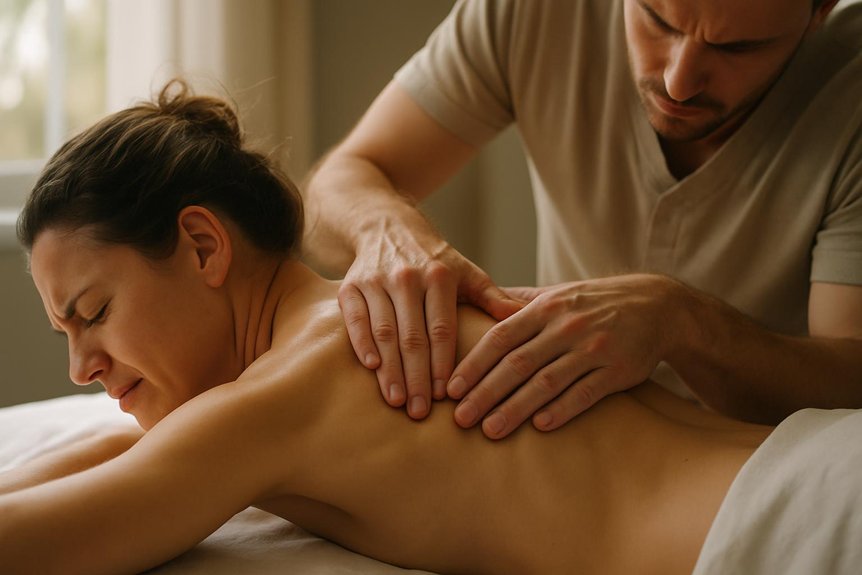
Although commonly described as a “pinched” nerve, the condition refers to mechanical compression and/or chemical irritation of a peripheral nerve or nerve root by surrounding tissues (e.g., intervertebral disc, osteophytes, swollen soft tissues, or tight musculature).
Resulting ischemia and inflammatory mediators can disrupt axonal conduction, producing pain and altered sensation along the nerve’s dermatome, and weakness in the corresponding myotome.
Patients often describe sharp, electric, or burning pain with tingling or numbness; cervical involvement may radiate to the arm and hand, lumbar involvement to the buttock and leg, sometimes into the foot.
Symptoms may intensify with positions that close neural foramina, and ease with gentle unloading.
At Spa & Massage, clinicians note guarded, protective movement patterns and sensitised soft tissues surrounding the affected pathway.
Additionally, a deep tissue massage can target tight musculature and soft tissue restrictions, which may contribute to nerve compression associated with a pinched nerve.
How It Targets Nerve-Related Pain
When nerve pain arises from mechanical compression or chemical irritation, it is applied to reduce nociceptive input by decreasing myofascial tension, improving local perfusion, and modulating neurogenic inflammation.
Targeted pressure along paraspinals, scalenes, piriformis, and forearm flexor-pronator compartments can ease entrapment near common bottlenecks—intervertebral foramina, thoracic outlet, sciatic notch, and carpal tunnel region.
Slow, graded strokes and sustained ischemic compression soften adhesions within endomysial and perimysial layers, lowering intramuscular pressure on adjacent nerve branches.
In Spa & Massage clinics, therapists assess dermatomal referral, altered sensation, and provocative movements, then apply depth only to tolerance, synchronising breath to downshift sympathetic arousal.
Gentle nerve-glide–compatible strokes are paired with heat to enhance capillary flow.
Clients are guided to lengthen shortened synergists, supporting decompression between sessions.
When It Is Appropriate—and When It’s Not
It is appropriate for stable, non-acute nerve compression linked to myofascial tightness, postural overload, or resolving muscle spasm. In these cases, graded pressure can reduce hypertonicity without provoking neurologic symptoms.
It should be avoided with red flags such as progressive motor weakness, severe or worsening numbness, bowel or bladder dysfunction, fever, unexplained weight loss, acute trauma, suspected fracture, active infection, or anticoagulation-related bleeding risk.
At Spa & Massage, therapists screen for these indicators and coordinate with medical providers when presentation suggests the need for imaging or urgent evaluation rather than manual intervention.
Suitable Cases
Determining suitability for this massage in suspected or confirmed pinched nerve cases requires careful screening of symptom pattern, onset, and red flags.
Appropriate candidates typically present with muscular hypertonicity compressing peripheral nerves—such as upper trapezius, scalene, or pectoralis minor tension aggravating cervical radiculopathy-like symptoms, or gluteal and piriformis tightness mimicking sciatic irritation.
Symptoms are stable, mechanical, and reproducible with posture or activity, with no progressive weakness. Pain responds to gentle pressure, heat, or movement, and dermatomal tingling is mild, intermittent, and improves with neural glides.
At Spa & Massage, therapists prioritise slow, targeted pressure into myofascial restrictions, integrating diaphragmatic breathing and graded stretch.
Suitable cases benefit from session pacing, reassessment of neural irritability, and a plan pairing tissue work with home mobility, hydration, and ergonomic cues.
When to Avoid
Clear exclusion criteria help prevent iatrogenic aggravation in suspected pinched nerve presentations. This massage therapy should be deferred when red flags are present: acute, unrelenting pain with progressive motor weakness; bladder or bowel changes; saddle anesthesia; fever, night sweats, or unexplained weight loss; recent trauma; suspected fracture; or new-onset severe neck pain with neurologic deficits.
It is also avoided over acute inflammation, cellulitis, open wounds, thrombosis, or active malignancy in the treatment field.
If pain is lancinating with dermatomal numbness, diminished reflexes, or myotomal weakness, prompt medical evaluation is prioritised. Anticoagulation, osteoporosis, and pregnancy warrant modified, gentler approaches.
At Spa & Massage in London, therapists screen carefully, collaborate with clients’ clinicians when needed, and pivot to lighter techniques, breath-led pacing, and comfort-focused positioning until clearance is obtained.
Techniques Our Therapists Use to Relieve Nerve Compression
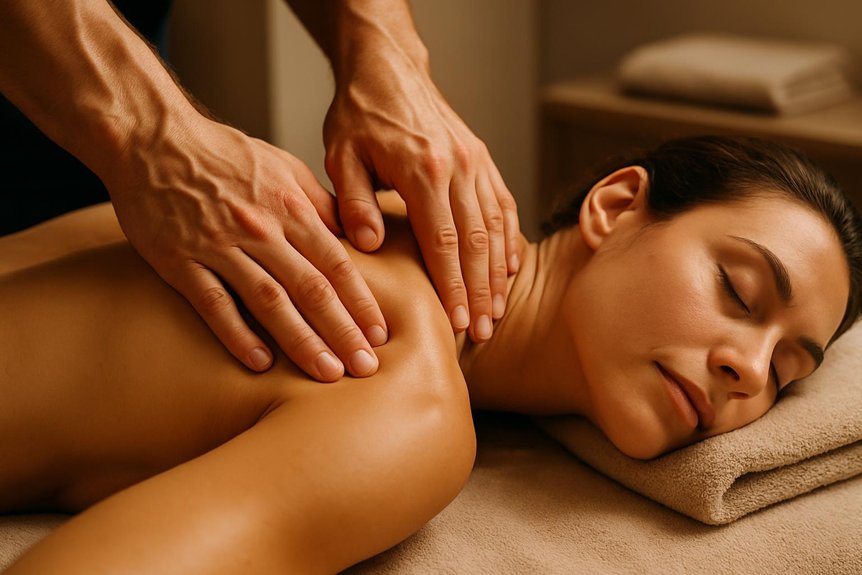
At Spa & Massage, therapists address nerve compression with targeted muscle release to reduce hypertonicity in specific fibers that compress neural pathways.
They apply myofascial trigger work to deactivate taut bands that refer pain along dermatomal or myotomal patterns.
When indicated, they incorporate gentle nerve gliding to promote neural mobility through surrounding fascia without provoking symptoms.
Targeted Muscle Release
A targeted muscle release protocol focuses on reducing myofascial hypertonicity that contributes to nerve compression, using anatomically guided palpation and graded pressure.
At Spa & Massage, therapists identify shortened, protective muscle bands along likely entrapment corridors—such as the scalenes over the brachial plexus, piriformis over the sciatic nerve, or quadratus lumborum near lumbar nerve roots.
They apply slow, sustained pressure parallel to fiber direction, then lengthen tissue through controlled passive positioning.
Pressure is titrated to client feedback and autonomic signs, avoiding reactive guarding.
Gentle nerve-protective positioning (slight joint flexion, slackened neural tissue) prevents irritation while adhesions are coaxed to yield.
Therapists track tissue glide, warmth, and resting tone changes as objective markers.
In our London clinics, this method complements assessment-led care and maintains a quiet, reassuring pace that invites ease.
Myofascial Trigger Work
Often central to relieving nerve irritation, myofascial trigger work at Spa & Massage targets hyperirritable nodules within taut bands that refer pain and provoke protective spasm near neural pathways.
Therapists palpate for localized tenderness, tautness, and jump signs, then apply graded ischemic compression, slow strumming, and sustained myofascial release along the involved fiber orientation.
Attention is given to regions that commonly entrap nerves—scalenes, pectoralis minor, suboccipitals, piriformis, and quadratus lumborum—reducing nociceptive drive and lowering muscle tone that compresses neural structures.
In our clinics, pressure is patiently titrated to client breath and autonomic cues, with controlled holds (20–90 seconds) followed by gentle lengthening to normalize sarcomere function.
Post-release, therapists reassess range, segmental tenderness, and neurodynamic irritability, refining the plan to maintain decompression and restore comfortable movement.
Gentle Nerve Gliding
While muscle tone is addressed, neural mobility also requires attention; Spa & Massage therapists incorporate gentle nerve gliding (neurodynamics) to restore excursion of irritated nerves without provoking symptoms.
Techniques are selected by dermatomal pattern and irritability: median nerve sliders for forearm and carpal tunnel discomfort, ulnar glides for cubital tension, radial glides for lateral forearm pain, and sciatic or tibial glides for lumbar–gluteal radiations.
Movements alternate distal and proximal joint excursions to mobilise the neural interface while maintaining sub-symptom thresholds.
Pressure from deep tissue work is sequenced first to reduce perineural muscle tone, then glides are layered with controlled breathing.
Therapists monitor symptom latency, resistance, and after-sensation.
Dosage is low-repetition, high-frequency home practice.
Contraindications—progressive neurologic deficit, acute inflammation—prompt referral.
What to Expect During and After Your Session
Before treatment begins, the therapist conducts a focused assessment—brief history, symptom mapping, and neurological screening (e.g., dermatomal sensation, myotome strength, provocative tests)—to confirm suitability for this massage in the context of suspected nerve irritation.
At Spa & Massage, pressure is introduced gradually, targeting myofascial bands, interscapular segments, hip rotators, or forearm flexors/extensors relevant to the involved nerve pathway.
Hypoallergenic oil is used to reduce shear while enabling slow, specific strokes, trigger-point compression, and nerve-adjacent fascial unloading without direct pressure on the nerve trunk.
Clients can expect therapeutic soreness, warmth, and a mild “release” sensation within the referral zone.
After the session, our therapists recommend hydration, gentle unloaded movement, and spacing sessions 5–10 days apart.
Indicators to pause therapy include progressive numbness, motor weakness, or escalating nocturnal pain—prompting referral.
Self-Care and Lifestyle Tips to Support Recovery
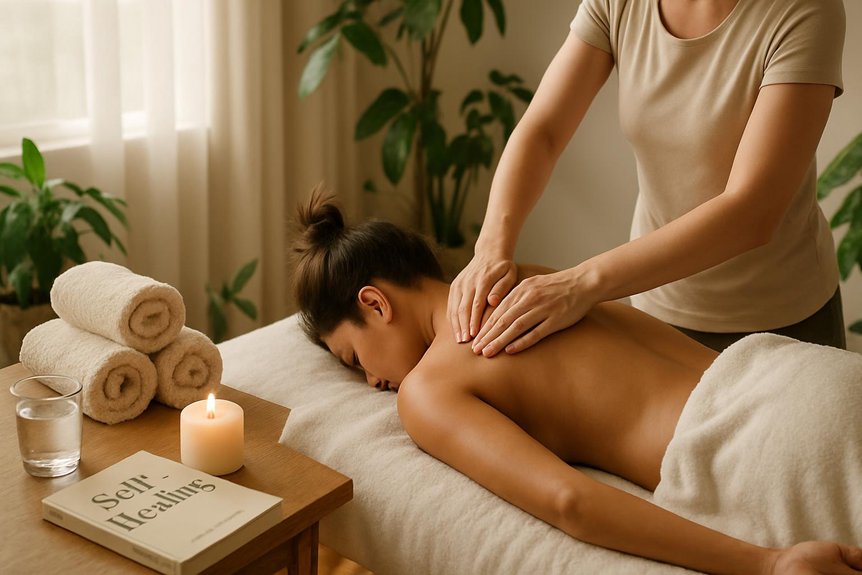
Following the in-clinic assessment and targeted deep tissue work, consistent self-management helps modulate nerve irritability and sustain gains.
Spa & Massage therapists recommend hydration to support fascial glide, gentle heat to paraspinals or gluteals to reduce guarding, and brief cold packs over acutely irritable segments to calm ectopic firing.
Clients are guided to perform pain-free nerve glides (median, ulnar, or peroneal as indicated), diaphragmatic breathing to downregulate sympathetic tone, and graded mobility—frequent micro-breaks, chin tucks, scapular setting, hip hinging.
Ergonomics matter: neutral cervical alignment, lumbar support, and forearm-height keyboards reduce compressive load.
Sleep in side-lying with a pillow maintaining cervical neutrality; avoid prolonged prone positioning.
In our clinics, therapists advise light walking post-session, magnesium-rich nutrition, and avoiding intense loading for 24–48 hours while monitoring symptom centralisation.
Choosing the Right Treatment Plan at Spa & Massage
How is an effective plan selected for a suspected pinched nerve at Spa & Massage? It begins with a focused consultation: onset, aggravating movements, dermatomal numbness or tingling, myotomal weakness, and red flags are reviewed.
Therapists palpate paraspinals, scalenes, piriformis, and proximal forearm flexors to identify compressive myofascial contributors. If red flags appear, referral is advised.
When appropriate, a phased plan is proposed. Phase 1 emphasizes pain modulation: gentle deep tissue with low-load, sustained pressure, nerve‑glide–friendly positioning, and aromatherapy to ease guarding.
Phase 2 progresses to targeted deep tissue or sports techniques on implicated structures (e.g., upper trapezius, levator scapulae, quadratus lumborum), with joint-friendly mobilizations.
Phase 3 consolidates gains: frequency tapers, home glides, ergonomics, and sleep positioning. Outcomes are tracked; plans adjust session by session.
Conclusion
In summation, this massage can ease muscle-driven nerve irritation when applied judiciously, but structural causes require medical review first. With anatomically targeted pressure, myofascial release, and graded dosing, therapists can reduce hypertonicity around nerve pathways and improve glide. Clear red flags, outcome monitoring, and home care keep patients safe and progressing. When massage fits the picture, it helps turn down the volume on nociception—slow and steady wins the race—supporting recovery alongside mobility work, ergonomic changes, and clinician oversight.
